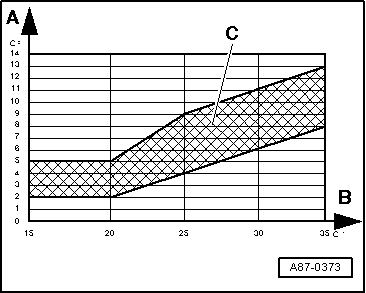
Note | t
| An absolute pressure of 0 bar represents an absolute vacuum. The normal ambient pressure is therefore equivalent to approx. 1 bar absolute pressure. In general most manometer scales represent atmospheric pressure as 0 bar meaning an absolute pressure of 1 bar (this can be recognised if there is a -1 on the scale). |
| t
| Pressure in refrigerant circuit depends on atmospheric temperature. Due to heat radiation from components (for example the coolant radiator), for a warm engine at normal running temperature, the indicated pressure is a above the corresponding atmospheric temperature. |
| t
| If the displayed pressure is lower than that given in the table: |
| t
| Check the output signal of the High pressure sender -G65- → Chapter. |
| t
| If no fault is found at high-pressure sender, there is not enough refrigerant in the circuit and vehicle must be taken to a specialist air conditioner workshop. |
| If pressure in refrigerant circuit is OK. |
| Vehicles fitted with Climatronic: |
| –
| Switch on the compressor by adjusting the operating mode „Auto“ on the Climatronic control unit -J255-. |
| –
| Select the lowest temperature setting (for driver and passenger side) on the Climatronic control unit -J255-. |
| –
| Adjust air outlet direction on the Climatronic control unit -J255- to the „dashboard vents“. |
| Vehicles fitted with Climatic: |
| –
| With the button „AC“ pressed, the speed „1“ of the Fresh air blower -V2- is selected along with the lowest possible temperature. |
| –
| Adjust air direction to the „instrument panel vents“ |
| All vehicles (continued): |
| –
| Check in the corresponding indication fields for a duty cycle of more than 30 % (the Compressor regulation valve, air conditioning -N280- is activated, the compressor is running), and a current intensity of more than 0.3 A (current flows through the Compressor regulation valve, air conditioning -N280-, the compressor is operating) |
| –
| Pressure in the refrigeration circuit rises above value with compressor off. |

Note | t
| The Compressor regulation valve, air conditioning -N280- is operated by the Climatronic control unit -J255-/Air conditioning control unit -J301- in such a way that the air temperature reaches the specified value (approx. 2 to 5℃) after the evaporator: |
| t
| After starting the vehicle, a value greater than 75 % (0.55 A) is displayed depending on the measured temperature, engine speed and electrical system voltage. |
| t
| As soon as the temperature measured by the Air temperature sender, evaporator output -G263- approaches the specification, the activation is reduced as is the compressor performance. |
| t
| Under certain conditions of use, ice may form on the regulation valve for the compressor (and on the expansion valve) because of humidity on the refrigeration circuit. Due to the formation of this ice, the regulation of the compressor is inhibited, the evaporator is cooled too much and will freeze. Freezing of the evaporator can lead to the following complaints: |
| t
| After a longer driving period, the air conditioner fails several times or every now and then (no cooling or heating performance). The function of the air conditioner is okay again after turning off the vehicle and after a brief waiting time. |
| t
| After a longer driving period, the windows mist up from the inside, even pressing the „Defrost“ button does not free the windows from the mist. The function of the air conditioner is okay again after turning off the vehicle and after a brief waiting time. |
| t
| If the measurement value is too high under the conditions described by the client (even though the climate control works correctly above, for example, 10°C, depending on the atmospheric temperature), test the Air temperature sender, evaporator output -G263- (the evaporator may freeze because of a measurement value error). |
| t
| If the measurement value of the sender is very low under the conditions described by the client (with an atmospheric temperature of more than 0℃, less than 0° for a long time), bring the vehicle to a workshop specialised in air conditioning. |
| t
| Check the refrigeration tubes from the evaporator (from the expansion valve) to the compressor (thick tube, low pressure side) while the engine is running. If the pipe is severely iced up by the problem described (thin ice layer is permissible), this is a further indication that the temperature in the evaporator is too low. Bring the vehicle to a workshop specialised in air conditioning. |
| t
| The specialist workshop can determine the error. The required work (draining the refrigerant circuit, replacing tanks and then allow the refrigerant circuit to drain for minimum 3 hours) can only be carried out by such specialist workshops. |
| t
| If, in the corresponding measurement block values, there is little or no current, check the activation of the Compressor regulation valve, air conditioning -N280- → Chapter. |
| t
| When the pressure displayed in the respective measured value block does not change and the controlling of the compressors is okay, there is a fault in the refrigerant line Bring the vehicle to a workshop specialised in air conditioning. |
| –
| Press the button for air recirculation on the Climatronic control unit -J255-/Air conditioning control unit -J301- (the symbol for the „air recirculation mode“ lights). |
| –
| Bring the engine speed up to 2.000 rpm (begin timing). |
| –
| Select the function „Read measurement block values“ for the indication group corresponding to the Air temperature sender, evaporator -G263-. |
|
|
|
 Note
Note Note
Note Note
Note Note
Note
 Note
Note Note
Note Note
Note Note
Note